Optimization techniques for mortars with self-compacting characteristics through Central Composite Design
Main Article Content
Abstract
The demand for concrete production for civil construction promotes an investment by researchers and builders to find methodologies that improve their performance, the costs and less environmental degradation. Self-compacting concrete works it possible to offer a mixture with high flowability and compaction and good mechanical properties. For a better optimization of the mixtures, the statistical tool Design of Experiments (DoE) was used. Therefore, the objective of this research was to optimize an experimental dataset of high strength self-compacting mortars, through statistical analysis, using the Response Surface Methodology (RSM) for a Central Composite Design (CCD). The results showed a strong correlation between the D-Flow and T-funnel response factors, when compared with CS14h and CS28d models that showed moderate significance. The input variable w/c was the most significant model. Numerical optimization solutions showed good accuracy and high compliance for low cost and environmental impact, maintaining high performance in fresh and hardened properties.
Downloads
Article Details

This work is licensed under a Creative Commons Attribution 4.0 International License.
Authors who publish with this journal agree to the following terms:
- Authors retain copyright and grant the journal right of first publication with the work simultaneously licensed under a Creative Commons Attribution License that allows others to share the work with an acknowledgement of the work's authorship and initial publication in this journal.
- Authors grant the journal the rights to provide the article in all forms and media so the article can be used on the latest technology even after publication and ensure its long-term preservation.
- Authors are able to enter into separate, additional contractual arrangements for the non-exclusive distribution of the journal's published version of the work (e.g., post it to an institutional repository or publish it in a book), with an acknowledgement of its initial publication in this journal.
- Authors are permitted and encouraged to post their work online (e.g., in institutional repositories or on their website) prior to and during the submission process, as it can lead to productive exchanges, as well as earlier and greater citation of published work (See The Effect of Open Access).

